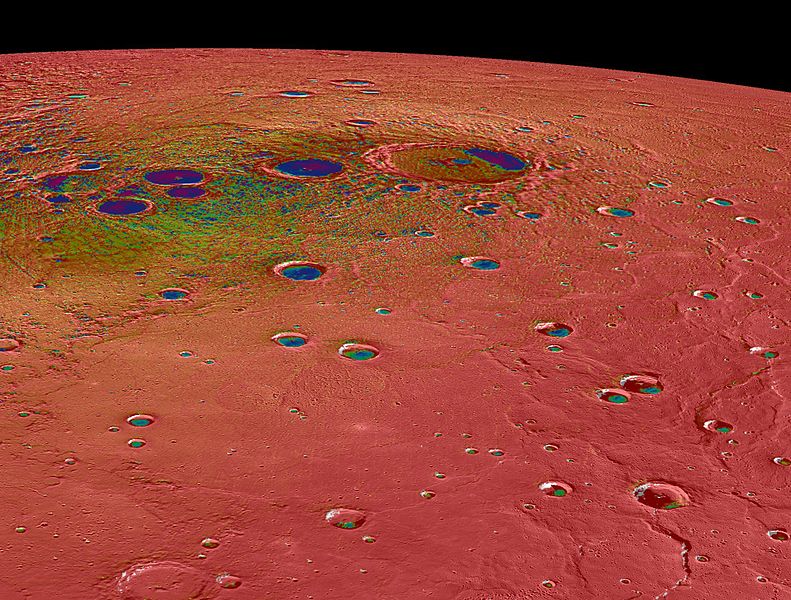|
تضامنًا مع حق الشعب الفلسطيني |
ملف:PIA19247-Mercury-NPolarRegion-Messenger20150316.jpg

الملف الأصلي (2٬044 × 1٬550 بكسل حجم الملف: 714 كيلوبايت، نوع MIME: image/jpeg)
| هذا ملف من ويكيميديا كومنز. معلومات من صفحة وصفه مبينة في الأسفل. كومنز مستودع ملفات ميديا ذو رخصة حرة. |
ملخص
| الوصفPIA19247-Mercury-NPolarRegion-Messenger20150316.jpg |
English: PIA19247: Hot and Cold
http://photojournal.jpl.nasa.gov/catalog/PIA19247 This view shows Mercury's north polar region, colored by the maximum biannual surface temperature, which ranges from >400 K (red) to 50 K (purple). As expected for the Solar System's innermost planet, areas of Mercury's surface that are sunlit reach high temperatures, and hence most of this image is colored red. In contrast, some craters near Mercury's poles have regions that remain permanently in shadow, and in these regions even the maximum temperatures can be extremely low. Evidence from MESSENGER and Earth-based observations indicate that water ice deposits are present in these cold craters. The craters nearest Mercury' poles have surface temperatures less than 100 K (-173°C, -280°F), and water ice is stable on the surface, such as in Prokofiev. However, many craters near but somewhat farther from Mercury's poles have cold, permanently shadowed interiors, but the maximum temperature is too high for water ice to persist at the surface. In these craters, water ice is present but is buried beneath a thin, low-reflectance volatile layer likely consisting of organic-rich material, such as in Berlioz crater. This image was presented at a press event at the Lunar and Planetary Science Conference. Visit the press event website to learn more! Scale: Prokofiev, the largest crater near the top center of the image, has a diameter of 112 km (70 miles) Prokofiev Center Latitude: 85.77° Prokofiev Center Longitude: 62.92° E Map Projection: Orthographic The MESSENGER spacecraft is the first ever to orbit the planet Mercury, and the spacecraft's seven scientific instruments and radio science investigation are unraveling the history and evolution of the Solar System's innermost planet. During the first two years of orbital operations, MESSENGER acquired over 150,000 images and extensive other data sets. MESSENGER is capable of continuing orbital operations until early 2015. |
| التاريخ | |
| المصدر | http://photojournal.jpl.nasa.gov/jpeg/PIA19247.jpg |
| المؤلف | NASA/Johns Hopkins University Applied Physics Laboratory/Carnegie Institution of Washington |
ترخيص
| Public domainPublic domainfalsefalse |
| يقع هذا العمل في النِّطاق العامّ في الولايات المُتحدة الأمريكيَّة لأَنَّه عملٌ خالِصٌ من إِنتاج وكالة الفضاء الأمريكيَّة. تنصُ حقوق التَّأليف والنَّشر الخاصَّة بوكالة الفضاء الأمريكيَّة على أنَّ "أعمال الوكالة غير مَحميَّة بحقوق التَّأليف والنَّشر ما لم يُذكر خلافُ ذلك". لمزيدٍ من المعلومات انظر القالِب {{PD-USGov}} وصفحة حقوق التَّأليف والنَّشر الخاصَّة بالوكالة وصفحة سياسة الصُّور الخاصَّة بمُختبر الدَّفع النَّفَّاث. |  | |
 |
تنبيهات:
|
| الشروح InfoField | هذه الصورة مشروحة: أظهر الشروح في كومنز |
Prokofiev
Kandinsky
Tolkien
Chesterton
الشروحات
العناصر المصورة في هذا الملف
يُصوِّر
١٦ مارس 2015
تاريخ الملف
اضغط على زمن/تاريخ لرؤية الملف كما بدا في هذا الزمن.
| زمن/تاريخ | صورة مصغرة | الأبعاد | مستخدم | تعليق | |
|---|---|---|---|---|---|
| حالي | 02:32، 17 مارس 2015 |  | 2٬044 × 1٬550 (714 كيلوبايت) | commonswiki>Drbogdan | User created page with UploadWizard |
استخدام الملف
ال1 ملف التالي مكررات لهذا الملف (المزيد من التفاصيل):
- ملف:PIA19247-Mercury-NPolarRegion-Messenger20150316.jpg من ويكيميديا كومنز
لا توجد صفحات تستخدم هذا الملف.